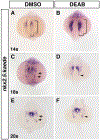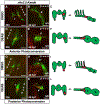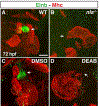Retinoic acid signaling restricts the size of the first heart field within the anterior lateral plate mesoderm
- PMID: 33607112
- PMCID: PMC7987825
- DOI: 10.1016/j.ydbio.2021.02.005
Retinoic acid signaling restricts the size of the first heart field within the anterior lateral plate mesoderm
Abstract
Retinoic acid (RA) signaling is required to restrict heart size through limiting the posterior boundary of the vertebrate cardiac progenitor field within the anterior lateral plate mesoderm (ALPM). However, we still do not fully understand how different cardiac progenitor populations that contribute to the developing heart, including earlier-differentiating first heart field (FHF), later-differentiating second heart field (SHF), and neural crest-derived progenitors, are each affected in RA-deficient embryos. Here, we quantified the number of cardiac progenitors and differentiating cardiomyocytes (CMs) in RA-deficient zebrafish embryos. While Nkx2.5+ cells were increased overall in the nascent hearts of RA-deficient embryos, unexpectedly, we found that the major effect within this population was a significant expansion in the number of differentiating FHF CMs. In contrast to the expansion of the FHF, there was a progressive decrease in SHF progenitors at the arterial pole as the heart tube elongated. Temporal differentiation assays and immunostaining in RA-deficient embryos showed that the outflow tracts (OFTs) of the hearts were significantly smaller, containing fewer differentiated SHF-derived ventricular CMs and a complete absence of SHF-derived smooth muscle at later stages. At the venous pole of the heart, pacemaker cells of the sinoatrial node also failed to differentiate in RA-deficient embryos. Interestingly, genetic lineage tracing showed that the number of neural-crest derived CMs was not altered within the enlarged hearts of RA-deficient zebrafish embryos. Altogether, our data show that the enlarged hearts in RA-deficient zebrafish embryos are comprised of an expansion in earlier differentiating FHF-derived CMs coupled with a progressive depletion of the SHF, suggesting RA signaling determines the relative ratios of earlier- and later-differentiation cardiac progenitors within an expanded cardiac progenitor pool.
Keywords: Atrium; Cardiomyocyte progenitors; First heart field; Heart development; Outflow tract; Retinoic acid signaling; Second heart field; Sinoatrial node; Ventricle; Zebrafish.
Copyright © 2021 Elsevier Inc. All rights reserved.
Conflict of interest statement
Declaration of competing interest The authors declare no competing interests.
Figures











Similar articles
-
Zebrafish second heart field development relies on progenitor specification in anterior lateral plate mesoderm and nkx2.5 function.Development. 2013 Mar;140(6):1353-63. doi: 10.1242/dev.088351. Development. 2013. PMID: 23444361 Free PMC article.
-
Retinoic acid promotes second heart field addition and regulates ventral aorta patterning in zebrafish.Dev Biol. 2025 Jun;522:143-155. doi: 10.1016/j.ydbio.2025.03.013. Epub 2025 Mar 25. Dev Biol. 2025. PMID: 40147741
-
Tbx1-dependent and independent pathways promote six gene expression downstream of retinoic acid signaling to determine cardiomyocyte number in zebrafish.Dev Biol. 2025 Aug;524:17-28. doi: 10.1016/j.ydbio.2025.04.017. Epub 2025 Apr 29. Dev Biol. 2025. PMID: 40311730
-
Patterning of vertebrate cardiac progenitor fields by retinoic acid signaling.Genesis. 2021 Nov;59(11):e23458. doi: 10.1002/dvg.23458. Epub 2021 Oct 19. Genesis. 2021. PMID: 34665508 Free PMC article. Review.
-
Retinoic acid signaling in heart development.Genesis. 2019 Jul;57(7-8):e23300. doi: 10.1002/dvg.23300. Epub 2019 Apr 25. Genesis. 2019. PMID: 31021052 Review.
Cited by
-
A Foxf1-Wnt-Nr2f1 cascade promotes atrial cardiomyocyte differentiation in zebrafish.bioRxiv [Preprint]. 2024 Mar 19:2024.03.13.584759. doi: 10.1101/2024.03.13.584759. bioRxiv. 2024. Update in: PLoS Genet. 2024 Nov 4;20(11):e1011222. doi: 10.1371/journal.pgen.1011222. PMID: 38558972 Free PMC article. Updated. Preprint.
-
A Foxf1-Wnt-Nr2f1 cascade promotes atrial cardiomyocyte differentiation in zebrafish.PLoS Genet. 2024 Nov 4;20(11):e1011222. doi: 10.1371/journal.pgen.1011222. eCollection 2024 Nov. PLoS Genet. 2024. PMID: 39495809 Free PMC article.
-
The molecular mechanisms of cardiac development and related diseases.Signal Transduct Target Ther. 2024 Dec 23;9(1):368. doi: 10.1038/s41392-024-02069-8. Signal Transduct Target Ther. 2024. PMID: 39715759 Free PMC article. Review.
-
Effect of a retinoic acid analogue on BMP-driven pluripotent stem cell chondrogenesis.Sci Rep. 2024 Feb 1;14(1):2696. doi: 10.1038/s41598-024-52362-3. Sci Rep. 2024. PMID: 38302538 Free PMC article.
-
Modeling Human Cardiac Arrhythmias: Insights from Zebrafish.J Cardiovasc Dev Dis. 2022 Jan 5;9(1):13. doi: 10.3390/jcdd9010013. J Cardiovasc Dev Dis. 2022. PMID: 35050223 Free PMC article. Review.
References
-
- Begemann G, Schilling TF, Rauch GJ, Geisler R, Ingham PW, 2001. The zebrafish neckless mutation reveals a requirement for raldh2 in mesodermal signals that pattern the hindbrain. Development 128, 3081–3094. - PubMed
-
- Buckingham M, Meilhac S, Zaffran S, 2005. Building the mammalian heart from two sources of myocardial cells. Nat. Rev. Genet 6, 826–835. - PubMed
Publication types
MeSH terms
Substances
Grants and funding
LinkOut - more resources
Full Text Sources
Other Literature Sources
Molecular Biology Databases

